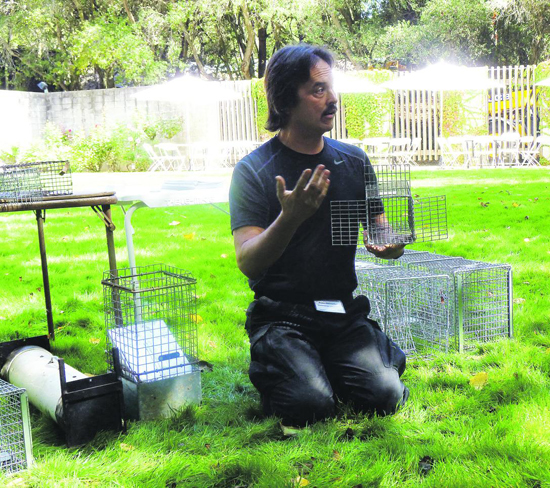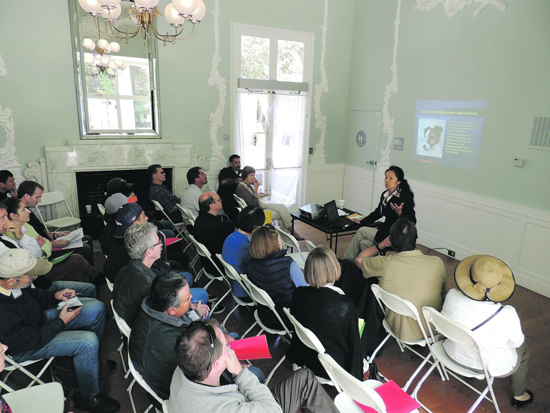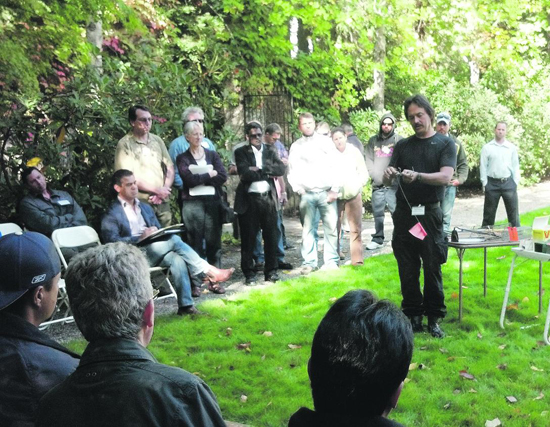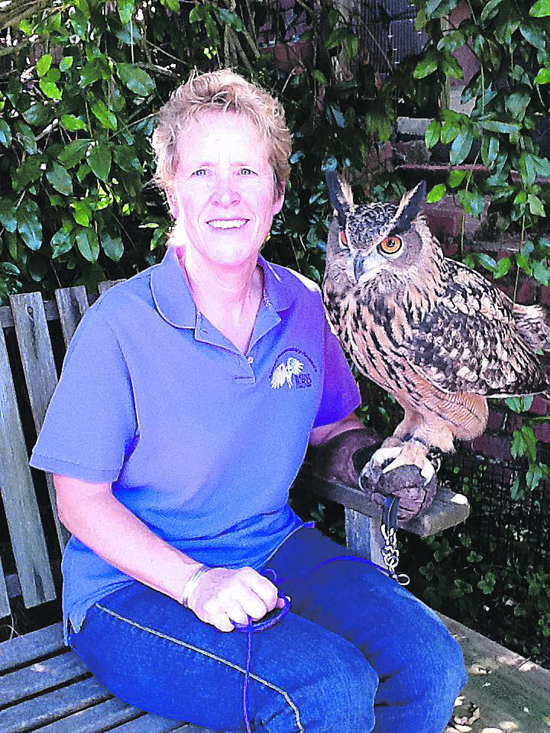| | Published November 20th, 2013
| Taking Care of Pests Without Pesticides
| | By Sophie Braccini |  | | James Schmerker with a skunk trap. Photo Sophie Braccini
|
Jenny Papka knows all too well that the use of rodenticides, the poisons to get rid of gophers, rats, mice, or voles, can end up being a catastrophe for other wildlife. The co-owner of Lamorinda-based Native Bird Connections, who owns 16 non-releasable birds of prey that she partners with to educate residents of all ages, says: "It's lethal, it's hideous." She recently cited figures from UC Davis that showed high levels of poisoning, often lethal, in 70 to 80 percent of the sick birds that come their way.
 Papka is a supporter of Parents for a Safer Environment's training campaign designed to show residents ways to get rid of pests of all sizes, inside and outside the home, without using chemicals. At a recent day-long training session in Moraga conducted by PfSE, the public and representatives of local agencies were invited to learn about alternatives to pesticides and rodenticides.
Papka is a supporter of Parents for a Safer Environment's training campaign designed to show residents ways to get rid of pests of all sizes, inside and outside the home, without using chemicals. At a recent day-long training session in Moraga conducted by PfSE, the public and representatives of local agencies were invited to learn about alternatives to pesticides and rodenticides.
 "The Department of Fish and Wildlife are finding out that every animal has traces of rodenticide in their systems, even road-kills," said PFSE founder Susan JunFish at the training session. "[Veterinarians] are finding out that pets are also being affected."
"The Department of Fish and Wildlife are finding out that every animal has traces of rodenticide in their systems, even road-kills," said PFSE founder Susan JunFish at the training session. "[Veterinarians] are finding out that pets are also being affected."
 One of the main strategies James Schmerker from Animal Damage Control suggests to deal with the problem, pesticide free, is to use different types of traps for rats, mice, gophers and voles. "For rats we recommend the raticator," said JunFish. The trap gives a deadly electric shock to the rodent. For mice, regular wooden mousetraps should be placed in the direction mice would be traveling, like along a wall or an edge, affixed with putty.
One of the main strategies James Schmerker from Animal Damage Control suggests to deal with the problem, pesticide free, is to use different types of traps for rats, mice, gophers and voles. "For rats we recommend the raticator," said JunFish. The trap gives a deadly electric shock to the rodent. For mice, regular wooden mousetraps should be placed in the direction mice would be traveling, like along a wall or an edge, affixed with putty.
 Traps are also the best option for bigger pests: raccoons, skunks and ground squirrels. "If you have skunks under your house, you can use a one way door trap," said Schmerker. "Attach it to the access where the skunk goes in and out or under your house. If they are not in breeding season, you will have no problem catching them.
Traps are also the best option for bigger pests: raccoons, skunks and ground squirrels. "If you have skunks under your house, you can use a one way door trap," said Schmerker. "Attach it to the access where the skunk goes in and out or under your house. If they are not in breeding season, you will have no problem catching them.
 "You need a much stronger trap with locking doors that can stop a raccoon," he added. "In a smaller skunk trap, a raccoon would be able to open the doors with its hands and destroy it." And he recommended leaving opossums alone. "They may be ugly, but they are like a cleaning crew in your garden and they will eat grubs. They are not too problematic in yards, they don't even eat fruit, and they're pretty mellow."
"You need a much stronger trap with locking doors that can stop a raccoon," he added. "In a smaller skunk trap, a raccoon would be able to open the doors with its hands and destroy it." And he recommended leaving opossums alone. "They may be ugly, but they are like a cleaning crew in your garden and they will eat grubs. They are not too problematic in yards, they don't even eat fruit, and they're pretty mellow."
 In 2011, the Town of Moraga caught 95 gophers in three and a half months utilizing Victor Black Hole traps, and in 2012 it caught 57 gophers in two and a half months, according to Moraga Public Works superintendent Dan Bernie. "With proper training, this can be a very effective way of limiting gophers in your lawn," he said.
In 2011, the Town of Moraga caught 95 gophers in three and a half months utilizing Victor Black Hole traps, and in 2012 it caught 57 gophers in two and a half months, according to Moraga Public Works superintendent Dan Bernie. "With proper training, this can be a very effective way of limiting gophers in your lawn," he said.
 Steve Fishbaugh, maintenance operation and transportation director for the Acalanes Union High School District, got rid of about 150 gophers over six months at the local high schools using Cinch traps. "Praise the school district for agreeing to be pesticide free," commented Papka, "and for agreeing to give me some of their catch to feed my birds."
Steve Fishbaugh, maintenance operation and transportation director for the Acalanes Union High School District, got rid of about 150 gophers over six months at the local high schools using Cinch traps. "Praise the school district for agreeing to be pesticide free," commented Papka, "and for agreeing to give me some of their catch to feed my birds."
 "Carbon dioxide is also an alternative to kill gophers," said JunFish, "but it also kills anything in the burrows including salamanders, burrowing owls, and snakes."
"Carbon dioxide is also an alternative to kill gophers," said JunFish, "but it also kills anything in the burrows including salamanders, burrowing owls, and snakes."
 Another effective way to deal with rodents is with owls. The Town of Moraga set up two owl boxes in local parks, with two nestlings sighted per year. One barn owl nest box houses a family of these beneficial raptors that can consume up to 3,000 rodents per year. "When we clean up the boxes in the middle of November, we find 4- to 5-inch-high stacks of rodent bones," said Bernie.
Another effective way to deal with rodents is with owls. The Town of Moraga set up two owl boxes in local parks, with two nestlings sighted per year. One barn owl nest box houses a family of these beneficial raptors that can consume up to 3,000 rodents per year. "When we clean up the boxes in the middle of November, we find 4- to 5-inch-high stacks of rodent bones," said Bernie.
 Shortly after the presentation, Fishbaugh confirmed that the AUHSD is now considering installing a network of owl boxes at local high schools so the predators will also dispose of the rodents, thus reducing the amount of needed labor.
Shortly after the presentation, Fishbaugh confirmed that the AUHSD is now considering installing a network of owl boxes at local high schools so the predators will also dispose of the rodents, thus reducing the amount of needed labor.
 "Barn owls require 150 grams of food a night," explained John Schuster of Wild Wing Company. "That's three voles or seven deer mice. Great horned owls can extract gophers from their hole because they hunt by sound, not sight." Schuster added that when babies are born the amount of food needed multiplies. The difficulty is placing the box at the right location on a specific property. "Owls do not hunt directly next to their nest, they cover a wide circle away from it," said Schuster. "A solution is to have three boxes positioned in a triangle to cover an entire neighborhood."
"Barn owls require 150 grams of food a night," explained John Schuster of Wild Wing Company. "That's three voles or seven deer mice. Great horned owls can extract gophers from their hole because they hunt by sound, not sight." Schuster added that when babies are born the amount of food needed multiplies. The difficulty is placing the box at the right location on a specific property. "Owls do not hunt directly next to their nest, they cover a wide circle away from it," said Schuster. "A solution is to have three boxes positioned in a triangle to cover an entire neighborhood."
 New techniques are also available for the tiniest of pests - termites - without having to fumigate the entire house. Chris Garcia from ATCO Pest Control said they use acoustic emissions for termite detection. "Our Termite Tracker detects both dry wood and subterranean termites actively eating and communicating within the galleries of the wood," he said, adding that the sonic technology can detect very small infestations, with as little as six termites. "We locally treat infested areas by drilling a small hole into the chambers created by the termites. We then inject Premise Foam into the wood, filling the entire chamber and killing the termites. The residual foam is absorbed into the wood, thus preventing any further infestation for approximately two to three years."
New techniques are also available for the tiniest of pests - termites - without having to fumigate the entire house. Chris Garcia from ATCO Pest Control said they use acoustic emissions for termite detection. "Our Termite Tracker detects both dry wood and subterranean termites actively eating and communicating within the galleries of the wood," he said, adding that the sonic technology can detect very small infestations, with as little as six termites. "We locally treat infested areas by drilling a small hole into the chambers created by the termites. We then inject Premise Foam into the wood, filling the entire chamber and killing the termites. The residual foam is absorbed into the wood, thus preventing any further infestation for approximately two to three years."
 Jon Nelson from Alliance Environmental Services stated that, according to the California Department of Consumer Affairs, the only two effective methods for total, whole-house eradication of termites are fumigation and heat. "The heating process introduces clean, dry heat into a structure, gradually increasing the temperature until the inside temperature is between 140 and 150 degrees and the wood core reaches 120 degrees," he explained, "Technicians then maintain the temperature at or above that level for 1.5 hours to ensure a complete kill. The entire procedure may be completed in as little as 8 hours."
Jon Nelson from Alliance Environmental Services stated that, according to the California Department of Consumer Affairs, the only two effective methods for total, whole-house eradication of termites are fumigation and heat. "The heating process introduces clean, dry heat into a structure, gradually increasing the temperature until the inside temperature is between 140 and 150 degrees and the wood core reaches 120 degrees," he explained, "Technicians then maintain the temperature at or above that level for 1.5 hours to ensure a complete kill. The entire procedure may be completed in as little as 8 hours."
 The training day was a huge success, offering many chemical-free pest control strategies.
The training day was a huge success, offering many chemical-free pest control strategies.
 "We had 71 registrants and it is very encouraging to see so many experts in the field of pest control providing options that work well, are cost effective, and safer than using poison," said JunFish, "We hope that residents and businesses, as well as public agencies would look at our web site to get resources and get started."
"We had 71 registrants and it is very encouraging to see so many experts in the field of pest control providing options that work well, are cost effective, and safer than using poison," said JunFish, "We hope that residents and businesses, as well as public agencies would look at our web site to get resources and get started."
 PFSE is raising funds to be able to assist schools and cities that want to adopt alternative methods of pest control. For more information, visit pfse.net.
PFSE is raising funds to be able to assist schools and cities that want to adopt alternative methods of pest control. For more information, visit pfse.net.

|
 | | Susan JunFish speaks during a recent workshop at the Hacienda de las Flores.
Photos Ron Whitehurst
|  | | James Schmerker with a gopher trap.
|  | | Jenny Papka | | | | | | | | | |
| | | print story
Before you print this article, please remember that it will remain in our archive for you to visit anytime.
download pdf
(use the pdf document for best printing results!) | | | Comments | | |
| | | | | | | | | | | | | | | | |





